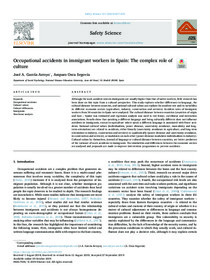Occupational accidents in immigrant workers in Spain: the complex role of culture

García-Arroyo, José A. ; Osca Segovia, Amparo
2020
121
January
507-515
occupational accidents ; migrant worker ; cultural change
Migration
https://doi.org/10.1016/j.ssci.2019.09.027
English
Bibliogr.
"Although the work accident rates in immigrants are usually higher than that of native workers, little research has been done on this topic from a cultural perspective. This study explores whether differences in language, the cultural distance between countries, and national cultural values can explain the accident rate and its variability in different economic sectors (agriculture, industry, construction and services). Accident rates of immigrant workers from 34 countries in Spain were analysed. The cultural distance between countries (countries of origin and host – Spain) was estimated and regression analysis was used to test linear, curvilinear and interaction associations. Results show that speaking a different language and being culturally different does not influence accidents in immigrants, except in agriculture where speak a different language is associated with fewer accidents. National cultural values (individualism, power distance, uncertainty avoidance, masculinity and long-term orientation) are related to accidents, either linearly (uncertainty avoidance in agriculture, and long-term orientation in industry, construction and services) or quadratically (power distance and uncertainty avoidance, in construction and services), or modulates on each other (power distance modulates individualism in industry). Cultural values by themselves, instead of language or cultural distance between countries, are better predictors of the variance of work accidents in immigrants. The similarities and differences between the economic sectors are analysed and proposals are made to improve intervention programmes to prevent accidents."
Digital
The ETUI is co-funded by the European Union. Views and opinions expressed are however those of the author(s) only and do not necessarily reflect those of the European Union or the ETUI.